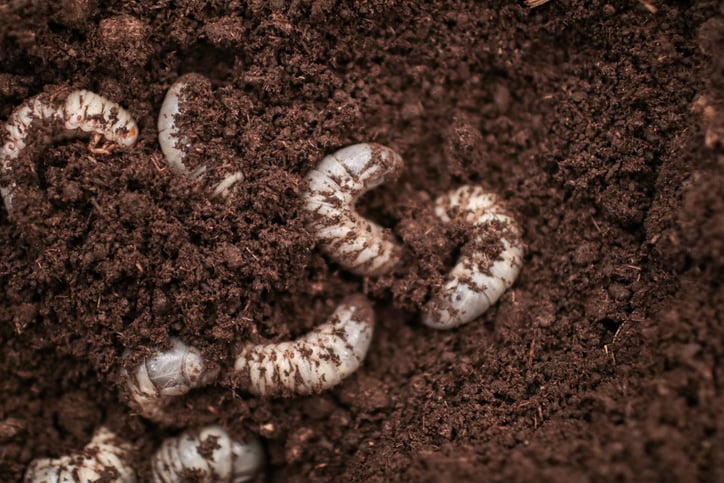If you’re noticing that your lawn is not thriving as you had hoped this summer, the problem may have actually started in the spring. As soon as winter ends, grubs become active. They start to damage your lawn by eating grassroots at a high rate.
But the problem is that it may take a little while to notice the damage. When you do, it’s important to act fast to get them under control.
So let’s take a look at what grubs are, what they can do to your lawn and how you can keep them under control.
What Are Grubs?
Lawn grubs, often called white grubs, are the immature forms of different scarab beetles, such as Japanese beetles, the green June beetle, or the European chafers. In Michigan, the most destructive white grubs found in lawns and gardens are the larvae of Japanese beetles and the European chafer.
Grubs are milky-white or cream-colored. They are worm-like creatures with brown heads and three pairs of legs that are curled into a C shape. A few grubs aren't a big deal. But too many cause irregularly shaped sections to wilt and die.
Signs You Have Grubs
If you have grubs feeding on your lawn roots, there are a few telltale signs that will tip you off.
- Dead patches in the lawn: You’ll start seeing yellow or brown patches. These are dead spots in your grass. It will also look like the grass is thinning out in those spots.
- A spongy turf: Grubs will damage the roots of turfgrass. This will make your grass easy to pull. You may even be able to roll it up like a carpet. An easy way to find out is to tug on a section of your lawn to see if it is attached to the soil.
- Increased raccoon and bird activity: Birds, moles and raccoons feed on grubs and other insects on the lawn.
You can check for grubs by cutting into your lawn near the edge of a brown patch and then lifting the sod. If it comes up easily, you've got grubs. And chances are, you'll even see them having their way. But you don’t have to put up with your grub problem.
When To Treat For Grubs
If you’re just noticing your lawn damage now (summer), it’s OK. Grubs are hard to treat in the spring. The spring rains also make it hard because the rain will wash away insecticides before they can work.
Grubs love to eat. So they typically start in the middle of spring, usually April. It’s about the same time they’ll become adult beetles.
Then, around mid-summer, the female beetles lay their eggs on the lawn. They hatch in the middle of August and the larvae (grubs) start feeding on your roots. This lasts through the early fall.
Proper timing of any grub preventative treatment is essential for success. So, some products need to be applied early to mid-July, prior to the grubs hatching. Other products need to be applied earlier when the beetles are still larvae.
How To Control Grubs
When you’re choosing an insecticide, keep this in mind. Find a grub control that targets the pests before they lay their eggs. This will take out your grub infestation from top to bottom.
It’s much harder to get rid of grubs after the egg-laying process and even harder after they hatch, but it’s not impossible.
Preventing Grub Infestations
The best way to save your grub-infested lawn is by properly irrigating it. Daily watering promotes grass growth and counteracts root damage caused by grubs. Maintaining a healthy lawn will allow it to better withstand grub attacks.
You can also introduce beneficial nematodes to your lawn. They’re microscopic worms that live in the soil, burrowing inside and killing grubs. They’ll prevent grub populations from reaching destructive levels.
You can apply them using a watering can, a sprayer, or a hose attachment. You can also use a misting system. It's a good idea to apply your nematodes during low-light periods (morning or evening are best).
Lush Lawn Can Help
If you’d like to eliminate the worry of grub once and for all, Lush Lawn can help. Our grub killer application will stop them from doing any further damage. It will not only eliminate active grubs in your soil, but it will keep new larvae from developing, too.
